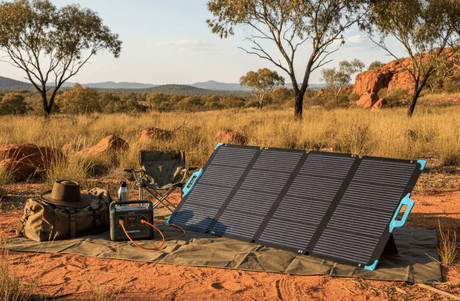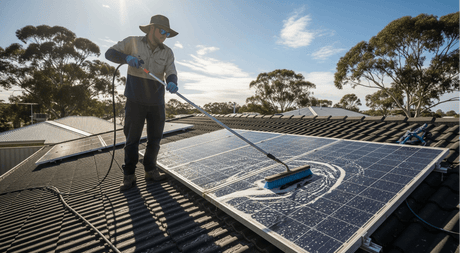Subhead: Protecting your system from lightning
Lightning is the number one cause of catastrophic failures in solar installations. This is why it’s important to add a proper grounding system to your solar installation. Do solar panels attract lightning and put your home at increased risk? What can you do to protect it?

Do solar panels attract lightning? What happens when lightning strikes a solar panel?
This is a common misconception. No, solar panels do not attract lighting. Putting solar panels on your roof will not increase your home’s risk of getting hit by lightning.
When lightning directly strikes a panel, it can melt the panel or inverter. Indirect strikes will induce high voltages into the system and break down conductors, PV panels, and components. They’ll also produce dangerous sparking that can ignite combustible material.
How can I ground my solar installation?
To ground your solar installation you need to give lightning a path to the ground. After all, you can’t prevent a lightning strike, but you can prevent damage. Panel frames and mounts should be grounded in order to provide the easiest path for lightning to get to the earth. An electric path to the ground will also discharge static electricity that accumulates above ground.
To ensure your system is always protected, we recommend installing your grounding system before or at the same time as you install the rest of your solar installation .A grounding system can consist of one or more lightning rods, wiring, arrestors, and surge protectors. Grounding your system can cost anywhere between $500 and $3,500.
Lightning arrestors and surge protectors can also be used to protect electronic equipment by absorbing electrical surges. However, keep in mind those arrestors, surge protectors, fuses, and breakers are not a good substitute for grounding. In an ideal setup, they function in conjunction with effective grounding.
What does grounding do?
As mentioned above, grounding fulfills some essential functionalities, including:
- Draining off accumulated charges so lightning is not highly attracted to your system.
- Providing a safe path for discharge directly to the earth if lightning strikes
- Reducing shock hazard from the higher voltage parts of your system.
- Eliminatesd electric hum caused by your inverters
What are arrestors and capacitors?
Surge arrestors, which go across live wires, act like clamps in your system. They offer a discharge path to the earth, rather than allowing current to flow through your electronics. If the voltage goes above a certain level, they will direct the higher voltage to ground.
Surge capacitors act as a secondary back-u to arrestors and catch high voltage spikes on the AC line that are too fast for the surge arrestor to catch.
Will fuses and breakers protect me from lightning strikes?
No, contrary to popular belief, fuses and circuit breakers offer no protection to lightning strikes. That is not their purpose. Lightning usually only lasts for a few microseconds. This is much faster than any fuse or breaker can blow.

What’s in a grounding system?
There are two main grounding system types, equipment grounding and system grounding.
- Equipment grounding: This is the more traditional and visible form of grounding. Any metal or potentially conductive materials that are likely to be energized in the system must be grounded. Equipment grounding is known as safety grounding or protective earthing.
- System grounding: In system grounding, one of the current-carrying conductors is connected to the equipment grounding system and also to the earth. This is also known as functional grounding. In system grounding, one of the two conductors coming out of the PV system will be grounded, typically the negative wire. System grounding will also include a ground fault fuse to prevent fires within the system from excessive current flowing into the ground.
What are the different grounding types?
You may be familiar with a single metal grounding rod, but there’s a range of other grounding options available.
- Single Point Ground: In this scenario, a ground wire connects to a ground rod or ground wire under the electric meter.
- Ring Ground: A #2 AWG bare wire is buried a minimum depth of 30" in the soil encircling a structure.
- Ufer Ground: In this grounding type, metal bars that are encased in concrete and buried a few feet under ground. This is used when terrain or other physical barriers prevent single point grounding.
- Isolated Ground: This is a separate, insulated safety ground wire that connects an equipment cabinet to the nearest ac distribution neutral-ground bond. It is used to maintain isolation from building conduit, which can conduct high frequency noise during an electrical storm.
- Halo Ground: This setup consists of bare or insulated wire and runs around the ceiling of a structure and connected to the corners of a buried ring ground.
How do I ground my system?
To give you an idea of what a grounding system can look like, here’s a breakdown of what a single rod installation can look like.
- First you’ll drive a grounding rod at least eight feet deep into the earth near your solar installation.
- Leave around 6” above the ground to properly attach your wiring to the grounding rod. You can typically use a thick, bare copper wire to handle large electric currents like lightning.
- Run your wire up your pole mounting system and attach it to a grounding screw.
- Wrap the wire around the grounding screw and tighten the bolt. Trim off any excess wire.
Is a single grounding rod enough?
Typically, a single 6 to 8 foot ground rod is not enough to adequately protect your system. However, something is often better than nothing. You may have to use two to three 10-foot rods, all bonded together with #6 wire and copper wire clamps. In some cases, you may have to bury lengths of bare copper wire or copper pipe in trenches.
Conclusion
You can’t control the weather, but you can control how protected your solar installation is. Grounding your solar system with rods, wiring, arrestors, and surge protectors will ensure that if lightning strikes, your solar technology will be safe.







![What Is a DC to DC Battery Charger [Comprehensive Guide]](http://au.renogy.com/cdn/shop/articles/IMG_3829_bd86de74-31d6-49fd-b9d5-265bb723091d.jpg?v=1757582605&width=460)


